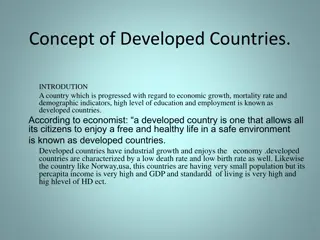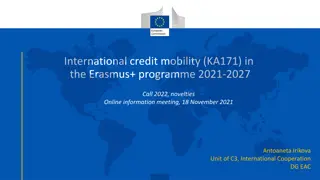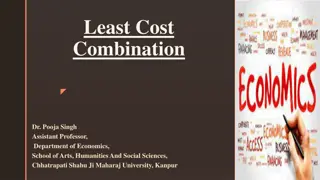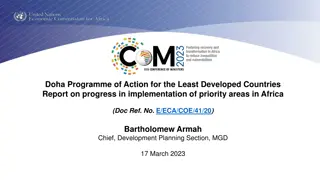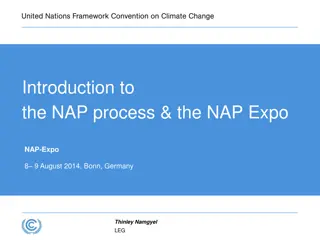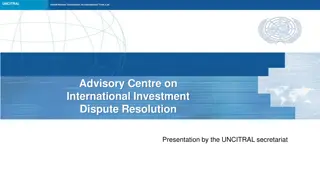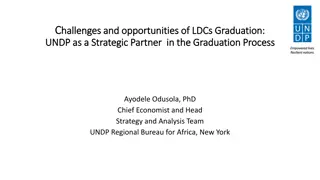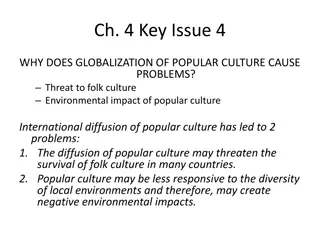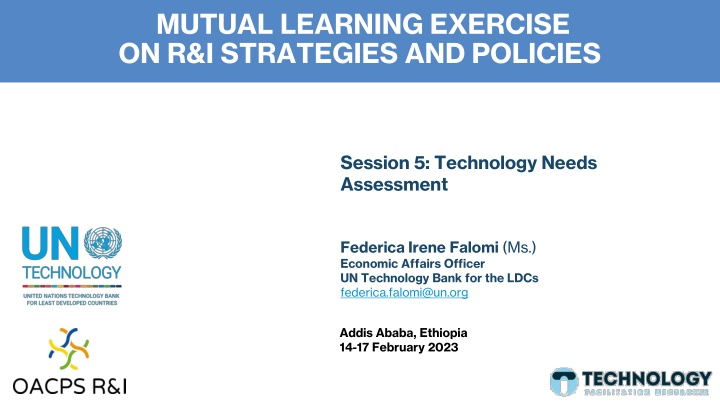
Technology Needs Assessment for Least Developed Countries
Technology Needs Assessment (TNA) is crucial for Least Developed Countries (LDCs) to identify key areas for technological advancements and strengthen their development plans. TNAs help prioritize technologies, address development challenges, and evaluate the enabling environment for technology utilization in LDCs.
Download Presentation

Please find below an Image/Link to download the presentation.
The content on the website is provided AS IS for your information and personal use only. It may not be sold, licensed, or shared on other websites without obtaining consent from the author. If you encounter any issues during the download, it is possible that the publisher has removed the file from their server.
You are allowed to download the files provided on this website for personal or commercial use, subject to the condition that they are used lawfully. All files are the property of their respective owners.
The content on the website is provided AS IS for your information and personal use only. It may not be sold, licensed, or shared on other websites without obtaining consent from the author.
E N D
Presentation Transcript
MUTUAL LEARNING EXERCISE ON R&I STRATEGIES AND POLICIES Session 5: Technology Needs Assessment Federica Irene Falomi (Ms.) Economic Affairs Officer UN Technology Bank for the LDCs federica.falomi@un.org Addis Ababa, Ethiopia 14-17 February 2023
The least developed countries LDCs are 46 low-income countries suffering the most severe structural impediments to sustainable and inclusive development. Countries are included into the category when they meet the established inclusion thresholds for all three criteria: GNI, HAI and EVI Common traits: small economies, isolation and remoteness from major markets, and low resilience/high vulnerability to external shocks Dependence on natural resource-based economic activities (agriculture, forestry, fishing, hunting, and mining) for employment, value added and exports Low level of productive capacities, high dependence on imports LDCs need to develop productive capacities: diversify economic structure and exports, upgrade the technologies with which the sectors operate No country achieved successful development without technological learning and upgrading and the development of innovative capabilities.
Technology and the SDGs STI cross cutting to all areas of sustainable development and sectors. Clear link between technology development and/or adoption and SDGs targets. Some examples: Increasing agricultural productivity (target 2.3) Maintain the genetic diversity of seeds (target 2.5) Economic productivity, diversification (target 8.2) Global resource efficiency (target 8.4) ICT for women empowerment (target 5.b) Maintain the genetic diversity of seeds (target 2.5) Sustainable housing and transportation (target 11.1, 11.2) Air quality and municipal waste (target 11.6) Renewable energy (target 7.2) Energy efficiency (target 7.3) Reduce food losses (target 12.3) Reduce waste generation, recycling (target 12.5)
Why Technology Needs Assessment? LDCs are the furthest behind to achieve the SDGs: where to start? TNAs help LDCs identify key areas where they can take advantage of technological opportunities needed to contribute to their development plans, and identify strategies for priority technologies to be transferred. Identify priority development challenges that can be addressed using technologies Identify and prioritize technologies that can address the priority needs in the LDCs Identify barriers/challenges for the applications of the technologies in the focal countries Evaluate the enabling environment for the utilization & application of the technologies Present implementation plans on how to strengthen the countries technological development
The TNA process 1. 3. 2. Examination of the wider STI environment, including SWOT Identification and prioritization of technologies in a sector of importance in the LDC s development plans Identification and prioritization of development challenges that can be addressed by utilising technologies 5. 4. Short-, medium- and long- term recommendations for technology implementation and STI strengthening Identification of barriers to the realization of the prioritized technologies The overall TNA framework is adapted to the contry context and needs Starting point: national development plans, ambitions, agendas + STI policy STI cut across different sectors and ministries, coordination and involvement of other NSI stakeholders through a Technology Working Group is essential
How to prioritize? What is the historical background of STI in the country? Who are the main actors/organizations that play a role in promoting the technological development? What system is in place to supports these actors (i.e. policies, funds, programs, legal frameworks, governance structure (i.e, institutional arrangements for managing STI), etc.)? 1. An examination of the wider STI environment, including an analysis of strengths, weaknesses, opportunities and threats (SWOT). Are there some success stories of technology development and implementation in the country? Has the country attempted to address its technological challenges and, if so, how? What are the main development needs of the country? What are the priority needs for technological development? Are there any ongoing STI initiatives to address these needs? What sector should the TNA focus on? What existing policies/regulations target the focal sector? What are the current technology capabilities in the sector? Who are the expected users of the technology? What are the organisations/firms working in the sector? 2. Identification and prioritization of particular development challenges that can be addressed by utilising technologies.
How to prioritize? 3. Identify and rank the main technologies that can address the priority needs focused on in the TNA Multi-criteria decision analysis, depending on number of tech solutions identified and complexity Prepare technology factsheets, including technical features and socio-economic features (e.g. gender dimensions) Identify possible barriers and enabling environments for the implementation of the technologies Identification and prioritization of technologies in a sector of importance to the LDC s needs 4. Identification of barriers to the realization of the prioritized technologies Once technologies are identified, a technology implementation plan looks at: Capacity to adopt and use (i.e, existing absorptive capacity), access to identified technology/transfer, risk factors, regulations, responsibilities, support needed
Key success factors Wide conceptualization of technology as the systematic knowledge and skills used in the process of production or service delivery. The knowledge can be based on science/research or on experience and can be embodied in products or in processes. TNA must be a country-driven process: political buy-in must be secured (demand driven) TNAs to build upon or contribute to similar ongoing processes countries to own the report and mobilize development partners to implement TNAs are participatory in nature: success depends upon coordination and involvement of all relevant stakeholders. It cannot be an exercise led by Ministries of STI/HE alone. Technology analysis needs to be informed by sectoral experts. Technology solutions are more likely to be understood, accepted and implemented if relevant stakeholders are involved throughout the process.
TNAs key sectors: often common priorities Out of 14 TNAs completed in LDCs: 86% 71% 71% 57% 43% Agriculture Education Health Energy Environment Completed Initiated Remaining LDCs
In practice TNA in Country X identified two priority sector of focus: Agriculture and Manifacturing Technology solutions identified: Technologies in the Affordable and Inclusive ( low-tech ) range Technologies in the high-tech range, that is, advanced technologies Online systems and platform technologies Technologies for e- businesses Low-tech solutions Key issues Greenhouses Biodigesters Status of the technology in the Country Existing institutions with capacities to develop and transfer this technology Outlined as focus area to support innovation and extension (MIN, 2018) MoA, cooperatives, some private sector, grassroots innovators, and entrepreneurs As FAO (2021) highlights, it is important, needs to be better exploited Inst. of Sc., Tech., and Mgt., academia...
In practice Key issues Greenhouses Biodigesters Will new capabilities be required? Yes funding, set up, operation. However, some capabilities already exist within the agriculture sector Farmers, agriculture sector ecosystem actors Farmers, agriculture ecosystem actors, SDGs Some capabilities exist e.g., in ISc; additional capabilities are essential for e.g., transfer of this technology Main beneficiaries Main benefits of implementing the technology 1. Increased productivity 2. Higher incomes and improved well-being 3. Addressing the SDGs 1-17 Can significantly enhance inclusion for women and youths 1. Lower production cost; higher incomes 2. Increased productivity 3. Addressing the SDGs 1-17 Can be operated by women and youths, fostering inclusion Gender dimension of the technology Environmental dimension of the technology If well managed, can reduce GHGs from farming Can help address challenges on energy and fertilizer use Main disadvantages of implementing the technology 1. Requires time, capabilities and skills for monitoring and management 2. Set up and maintenance costs 3. Others: pollination, maintaining regular supplies of nursery plans, aesthetics Low to medium 1. Initial set up and maintenance costs 2. Capabilities and skills gaps 3. Raw materials the challenge of maintaining a regular and sustainable supply of inputs Implementation cost estimate Low to medium
In practice Low-tech solutions Key issues Main features and objectives Status of the technology in the Country Existing institutions with capacities to develop and transfer this technology Will new capabilities be required? If yes, what will they be? How will this technology address the needs? Processing Central to production functions, value addition Cooling Mainly refrigeration, but other forms possible Requires more efforts to e.g., reduce post-harvest losses (PHL) in agriculture and improve Progress being made but far from the required level to help stem PHL in fruits and vegetables Multiple: private sector, academia, government. Capacities also available within the region Multiple: private sector, academia, government. Capacities also available within the region Yes equipment, funding, training, skills etc. Some of these can be obtained in-country and within the region Yes equipment, funding, training, skills etc. Some of these can be obtained in-country and within the region Cooling, e.g., via refrigeration, is an important aspect of storage and processing. Therefore, can contribute to stemming PHL and improve productivity, income and wellbeing of farmers and industrialists Processing is vital in 1) agriculture to stemming the high levels of PHL in fruits and vegetables - major export products for the Country, and 2) manufacturing, for value addition to raw materials e.g., textiles, minerals in readiness for export
In practice Low-tech solutions Key issues Main benefits of implementing the technology Gender dimension of the technology Environmental dimension of the technology Main disadvantages of implementing the technology Implementation cost estimate Processing 1. Reduced PHL 2. Increased productivity, profit, and wellbeing 3. Waste reduction; less impacts on environments Needs better articulation; to ensure good inclusion Cooling 1. Improved storage, extends shelf life 2. Reduced PHL 3. Waste reduction; less impacts on environments Needs better articulation; to ensure good inclusion Can increase impacts on environment e.g., via emission of GHGs and high energy use Can increase impacts on environment e.g., via use of chemicals in processing 1. Potentials for high impact on environment 2. Requires capabilities and skills, and finance 3. High energy costs/use Low, medium, or high depending on scale of implementation 1. Potentials for high impact on environment 2. Requires capabilities and skills, and finance 3. High energy costs/use Low, medium, or high depending on scale of implementation TIP needs to identify clear stakeholders capacities, roles and responsibilities across the National Innovation System for successful implementation NIS stakeholders' engagement in the process is essential at all stages
Contacts Email us for inquiries. Email federica.falomi@un.org Visit our website to learn more about UN Technology Bank. Website un.org/technologybank Follow us on Twitter for the latest news. @UNTechBank Twitter


